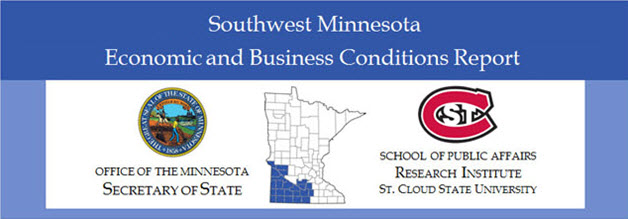Document Type
Research Study
Publication Date
6-2015
Abstract
Southwest Minnesota business conditions are expected to soften over the next several months according to the predictions of the St. Cloud State University (SCSU) Southwest Minnesota Index of Leading Economic Indicators (LEI). A decline in Mankato area residential building permits and last year’s weakness in new business filings helped push down the index in this year’s first three months. The LEI fell 22.22 points in the first quarter and is now 18.1 percent below its level one year ago. On a positive note, lower initial jobless claims in 2014 in the Southwest Minnesota planning area and a small improvement in the general outlook for rural economies contributed favorably to this quarter’s LEI.
There were 690 new business filings with the Office of the Minnesota Secretary of State in Southwest Minnesota in the first quarter of 2015 — representing 9.4 percent more new filings than one year ago. There were 62 new regional business incorporations in the first quarter, a 5.1 percent increase from one year ago. New LLC filings in Southwest Minnesota increased by 15.1 percent—rising to 405 in the first quarter of 2015. New assumed names totaled 194 in this year’s first quarter—8.9 percent fewer than last year. There were 29 new filings for Southwest Minnesota non-profits in the first quarter—a 314 percent increase from one year ago.
Employment of Southwest Minnesota residents jumped 5 percent over the year ending March 2015. More than 10,000 additional Southwest Minnesota residents have jobs than did one year ago. The regional unemployment rate was 4.8 percent in March, an improvement on its 5.4 percent reading in March 2014. Initial claims for unemployment insurance rose by 303 from year-ago levels—a 30.5 percent increase. The Southwest Minnesota labor force increased substantially over the past 12 months and job vacancies per 100 unemployed surged.
There was mixed economic performance in the Mankato/North Mankato Metropolitan Statistical Area (MSA)—the largest market in Southwest Minnesota. On the positive side, overall employment grew at an annual rate of 2 percent (led by rapid growth in goods-producing employment), the unemployment rate fell, the labor force expanded, and nearly all categories of new business filings rose. Showing weakness was Mankato area residential building permits, average weekly work hours, and average hourly earnings. Initial jobless claims in the Mankato area were also higher and the relative cost of living in the MSA appeared to rise.
Recommended Citation
Banaian, King and MacDonald, Richard A., "Southwest Minnesota Economic and Business Conditions Report - First Quarter 2015" (2015). Southwest Minnesota Economic and Business Conditions Report. 4.
https://repository.stcloudstate.edu/qebcr_sw_mn/4




